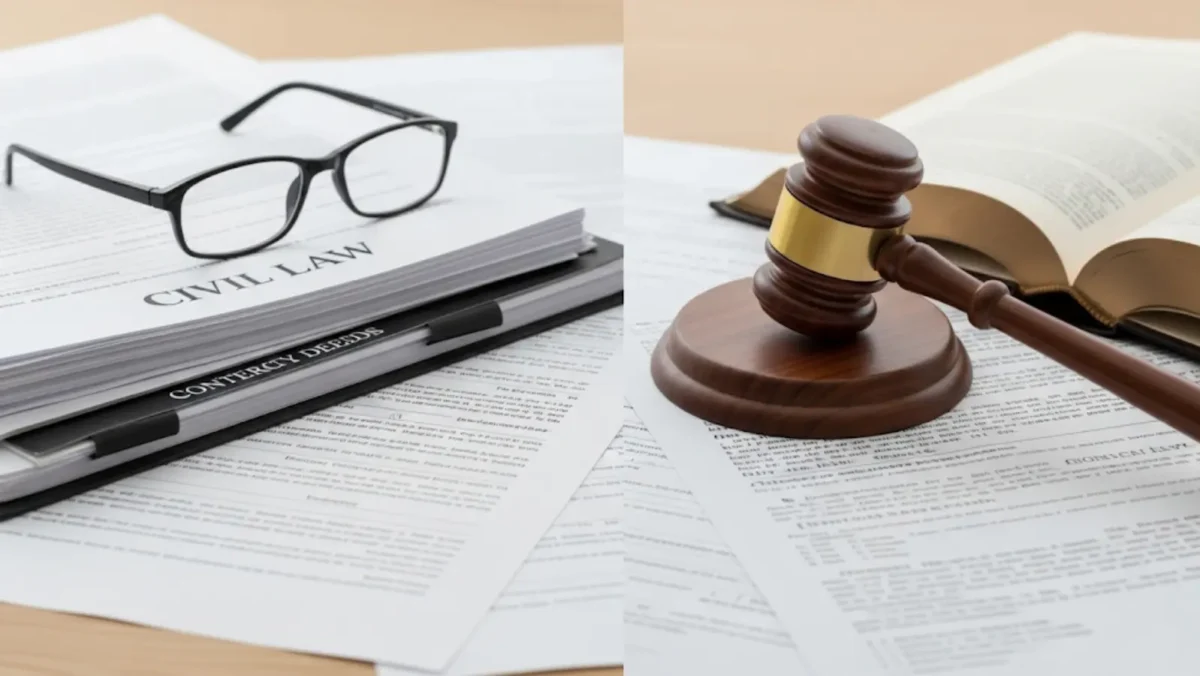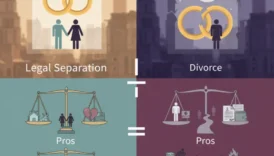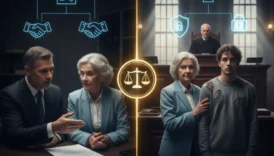Civil Law vs Criminal Law: Key Legal Distinctions

The legal system is often divided into two broad categories: civil law and criminal law. While both exist to uphold justice, they serve very different purposes, apply to different types of disputes, and impose different consequences. Civil law primarily deals with conflicts between individuals or organizations, such as contract disputes or personal injury claims. Criminal law, on the other hand, involves actions considered offenses against society as a whole, such as theft, assault, or fraud. Understanding the distinctions between these two areas of law is crucial, as the rights, procedures, and outcomes vary significantly depending on which type of case you are facing.
What Is Civil Law?

Civil law is the branch of the legal system that governs disputes between individuals, organizations, or both, where one party seeks compensation, restitution, or enforcement of rights rather than punishment. Unlike criminal law—which involves the government prosecuting individuals for offenses against society—civil law focuses on private disputes and the resolution of conflicts in a fair and orderly manner.
At its core, civil law deals with legal duties and rights between private parties. If someone breaches a contract, causes injury through negligence, or violates property rights, the injured party can file a civil lawsuit. The goal here is not to impose criminal penalties such as imprisonment but to restore balance by compensating the wronged party or enforcing obligations.
Main Characteristics of Civil Law
- Plaintiff vs. Defendant – The case is initiated by a private individual or organization (plaintiff) against another individual, organization, or even government entity (defendant).
- Compensation over Punishment – Civil remedies typically involve financial damages, injunctions (court orders to do or stop doing something), or specific performance (fulfilling a contractual obligation).
- Lower Burden of Proof – In civil cases, the standard of proof is usually a “preponderance of the evidence,” meaning it must be more likely than not that the defendant is responsible. This is a lower standard than in criminal law.
- Wide Range of Areas – Civil law covers contract disputes, family law matters (like divorce or custody), tort claims (like personal injury), property disputes, and more.
Example Scenario
Imagine a situation where one company fails to deliver goods as promised in a contract with another company. The harmed company may sue under civil law to recover financial losses. The court may order the breaching company to pay damages or complete the contract, but no criminal charges or imprisonment would be involved.
Why Civil Law Matters
Civil law plays a critical role in maintaining social order by providing a structured process to resolve disputes fairly. Without it, individuals and organizations might resort to self-help or informal methods that could lead to greater conflict. By offering legal remedies, civil law promotes accountability, trust in agreements, and peaceful resolution of disputes.
In short: Civil law is about rights, responsibilities, and remedies. It ensures that individuals and entities can seek justice and compensation when their legal rights are violated, without crossing into the punitive realm of criminal justice.
Common Examples of Civil Law Cases
Civil law encompasses a wide range of disputes, most of which arise from everyday interactions between individuals, businesses, or organizations. These cases are not about punishing someone for breaking the law in the criminal sense but about resolving conflicts and ensuring fairness. Below are some of the most common types of civil law cases:
1. Contract Disputes
Contracts form the backbone of many business and personal relationships. When one party fails to meet their obligations under a contract, the other party may sue for damages or request that the court enforce the agreement.
- Example: A homeowner hires a contractor to renovate a kitchen, but the contractor abandons the project midway. The homeowner may sue for the cost of hiring another contractor to finish the job.
2. Property Disputes
Property cases deal with ownership, boundaries, usage rights, and landlord-tenant conflicts.
- Example: Two neighbors disagree about the boundary line of their properties, and one builds a fence that the other claims encroaches on their land. The court decides who has legal ownership of the disputed area.
3. Family Law Cases
Family law falls under civil jurisdiction and includes sensitive matters such as divorce, child custody, child support, and alimony.
- Example: A divorcing couple disputes custody arrangements for their children. A judge issues a custody order based on the best interests of the child.
4. Tort Claims (Personal Injury)
A tort is a civil wrong that causes harm to another person, such as negligence, defamation, or intentional misconduct.
- Example: A driver runs a red light and crashes into another car. The injured driver sues for medical expenses, lost wages, and pain and suffering.
5. Employment Disputes
Disagreements between employers and employees often fall under civil law, especially when dealing with wrongful termination, wage disputes, or discrimination claims.
- Example: An employee sues an employer for wrongful dismissal after being fired without cause or proper notice.
6. Consumer Protection Cases
These cases involve unfair business practices, defective products, or fraud against consumers.
- Example: A consumer purchases an appliance that turns out to be dangerously defective. They may sue the manufacturer for damages.
Key Insight
Civil law cases are part of daily life. They ensure that individuals and organizations have a fair path to resolve disputes without resorting to violence or unfair advantage. Remedies usually take the form of monetary damages, injunctions, or specific performance, but the overall goal remains the same: to correct harm and restore balance.
What Is Criminal Law?

Criminal law is the branch of the legal system that deals with actions considered offenses against society as a whole, even if the harm is directed at an individual. Unlike civil law, which focuses on resolving disputes and compensating victims, criminal law is centered on maintaining public order, deterring wrongful conduct, and punishing offenders.
At its core, criminal law is based on the idea that certain acts are so harmful or dangerous that they violate not just the rights of a victim but the safety and well-being of the entire community. As a result, criminal cases are typically brought by the state or government rather than private individuals.
Main Characteristics of Criminal Law
- Prosecution by the State – The government, usually represented by a prosecutor or district attorney, brings charges against the accused (the defendant).
- High Burden of Proof – The standard in criminal law is “beyond a reasonable doubt.” This means the evidence must be strong enough to convince a jury or judge that the defendant is guilty with near certainty.
- Punitive Consequences – Penalties often include imprisonment, probation, community service, or fines. In some jurisdictions, severe crimes may carry life sentences or even the death penalty.
- Public Wrong vs. Private Wrong – While civil law addresses private disputes, criminal law treats crimes as public wrongs that affect society at large.
Example Scenario
Imagine a case where someone commits burglary. Even though the homeowner is the direct victim, the act itself is classified as a crime against society. The state prosecutes the offender not only to achieve justice for the homeowner but also to protect the broader community by punishing the behavior and deterring others.
Purpose of Criminal Law
- Deterrence: To discourage both the offender and others from committing similar crimes.
- Retribution: To impose punishment proportionate to the offense.
- Rehabilitation: To reform offenders so they can reintegrate into society.
- Protection: To remove dangerous individuals from society when necessary.
Why Criminal Law Matters
Criminal law is essential to maintaining order and public safety. Without it, individuals could engage in harmful acts without consequence, undermining trust in the legal system and endangering communities. By holding offenders accountable, criminal law reinforces societal norms and ensures justice extends beyond individual disputes.
In short: Criminal law is about crime, punishment, and societal protection. It reflects the state’s role in safeguarding the community against acts deemed harmful to the public good.
Common Examples of Criminal Law Cases
Criminal law covers a broad spectrum of conduct, from minor infractions to the most serious offenses. Each criminal case involves an alleged violation of a statute or law enacted to protect society. To better understand its scope, let’s look at some of the most common categories of criminal law cases.
1. Crimes Against Persons
These offenses directly harm individuals and are often treated with the greatest severity.
- Examples: Homicide, assault, battery, kidnapping, sexual assault.
- Impact: The victim suffers physical harm or the threat of harm, and penalties may include lengthy prison sentences.
2. Property Crimes
Property crimes involve interference with another person’s right to use or enjoy their property.
- Examples: Burglary, theft, robbery, arson, vandalism.
- Impact: Even when no physical harm occurs, the law treats property crimes seriously because they undermine security and economic stability.
3. White-Collar Crimes
Non-violent offenses usually committed in business or financial settings for personal or corporate gain.
- Examples: Fraud, embezzlement, insider trading, money laundering.
- Impact: These crimes can cause enormous financial damage and erode public trust in institutions.
4. Drug-Related Crimes
Offenses connected with the possession, distribution, manufacturing, or trafficking of illegal substances.
- Examples: Possession of controlled substances, drug trafficking, illegal prescription practices.
- Impact: Laws vary widely, but penalties often include imprisonment, fines, and rehabilitation programs.
5. Public Order Crimes
These crimes disrupt societal norms or threaten the well-being of the community.
- Examples: Disorderly conduct, public intoxication, loitering, disturbing the peace.
- Impact: While often less severe, repeated violations can escalate into more serious consequences.
6. Cybercrimes
With the rise of technology, cybercrimes have become a growing category of criminal law.
- Examples: Hacking, identity theft, online fraud, distribution of malicious software.
- Impact: Cybercrimes may target individuals, businesses, or even governments, making them a major modern legal challenge.
Key Insight
Criminal law addresses conduct considered unacceptable to society at large. Whether it involves violence, dishonesty, or disruption of public peace, the purpose of prosecuting these offenses is to protect communities, deter misconduct, and ensure accountability.
Parties Involved in Civil vs Criminal Law
One of the clearest ways to distinguish between civil and criminal law is by looking at who the parties are in each type of case. The roles of the individuals or entities involved determine not only how the case proceeds but also what kind of outcomes are possible.
Civil Law Parties
In civil law, disputes arise between private parties—individuals, organizations, or sometimes government entities acting in a non-criminal capacity.
- Plaintiff: The party who initiates the lawsuit, claiming they have suffered harm or loss because of the defendant’s actions.
- Defendant: The party accused of causing harm or failing to fulfill a legal obligation.
- Attorneys: Both sides are usually represented by private attorneys who present arguments, evidence, and negotiate settlements.
Example: In a personal injury case, an injured driver (plaintiff) sues another driver (defendant) for damages. The government is not involved as a prosecuting party, since the matter is a private dispute.
Criminal Law Parties
In criminal law, the case is fundamentally the state versus the individual accused of a crime.
- Prosecutor: Represents the government (local, state, or federal). Their duty is not just to secure a conviction but to pursue justice.
- Defendant: The individual accused of violating the law. Unlike civil cases, the defendant in a criminal case may face loss of liberty (imprisonment).
- Victim: While victims may play an important role in providing testimony or evidence, they are not technically the ones prosecuting the case. The state takes responsibility.
- Defense Attorney: Represents the defendant, ensuring their rights are protected throughout the process. If the defendant cannot afford an attorney, the court must provide one (public defender).
Example: In a burglary case, the state files charges against the accused burglar. The homeowner may testify as a witness, but the official case is “State vs. Defendant,” not “Homeowner vs. Burglar.”
Why the Difference Matters
- In Civil Law: The focus is on resolving a private dispute and compensating the injured party.
- In Criminal Law: The focus is on punishing wrongful conduct and protecting society at large.
Key Takeaway
In civil law, the parties are private individuals or organizations seeking remedies. In criminal law, the government acts on behalf of society to prosecute and potentially punish the accused. Recognizing this difference helps clarify why outcomes—such as financial compensation versus imprisonment—differ so dramatically.
Burden of Proof: Civil vs Criminal
One of the most important distinctions between civil and criminal law lies in the burden of proof—the level of certainty required to establish responsibility or guilt. This difference exists because the consequences in each type of case are vastly different.
Burden of Proof in Civil Law
In civil cases, the standard is typically “preponderance of the evidence.”
- This means the plaintiff must show that their claim is more likely true than not true—essentially a greater than 50% likelihood.
- Because the outcome usually involves financial compensation or court orders rather than loss of liberty, the threshold for proof is lower.
- Example: In a contract dispute, if the plaintiff can demonstrate through documents and witness testimony that it is more probable the defendant broke the agreement, they win.
In some civil cases, particularly those involving fraud or misconduct, courts may apply a slightly higher standard known as “clear and convincing evidence.” This still does not reach the level of criminal proof but requires stronger evidence than a mere preponderance.
Burden of Proof in Criminal Law
In criminal cases, the standard is “beyond a reasonable doubt.”
- The prosecutor must convince the jury or judge that the defendant committed the crime with near certainty, leaving no reasonable alternative explanation.
- This high standard reflects the gravity of criminal penalties—imprisonment, probation, or even life-altering sentences.
- Example: In a murder trial, if jurors believe there is any reasonable possibility that the defendant did not commit the crime, they must acquit.
Why the Difference Exists
The rationale behind these differing burdens is fairness:
- Civil cases involve money, property, or obligations, so the risk to the defendant is relatively limited.
- Criminal cases involve personal liberty and societal stigma. Wrongly convicting an innocent person is considered far more harmful than failing to resolve a private dispute.
Key Takeaway
- Civil law: Lower burden — “more likely than not.”
- Criminal law: Higher burden — “beyond a reasonable doubt.”
This distinction ensures that the severity of the case’s outcome is matched by the strength of evidence required, protecting both fairness in civil disputes and fundamental rights in criminal prosecutions.
Penalties and Remedies in Civil vs Criminal Cases
The outcomes of civil and criminal cases are perhaps the most visible distinctions between the two systems. While both aim to deliver justice, the forms of resolution they provide differ dramatically because the purposes of each branch of law are not the same.
Remedies in Civil Law
Civil law is primarily about compensation, correction, or enforcement. The goal is to make the injured party whole again or to enforce legal rights. Common remedies include:
- Monetary Damages
- The most common remedy in civil law.
- May include compensatory damages (to cover losses like medical bills or lost wages), punitive damages (to punish egregious conduct), or nominal damages (symbolic amounts acknowledging a wrong).
- Injunctions
- Court orders requiring someone to do or stop doing something.
- Example: A company may be ordered to stop using a trademark that belongs to another business.
- Specific Performance
- Instead of monetary damages, courts may require a party to fulfill their contractual obligations.
- Example: Forcing a seller to transfer property after breaching a real estate agreement.
- Declaratory Judgments
- Courts may issue rulings clarifying the rights and obligations of the parties without awarding damages.
Penalties in Criminal Law
Criminal law is about punishment and societal protection. Penalties are designed not only to penalize the offender but also to deter future misconduct and maintain order. Common penalties include:
- Imprisonment
- The most severe consequence, removing offenders from society for a set period.
- Sentences vary depending on the seriousness of the crime.
- Fines
- Monetary penalties paid to the state, not to the victim.
- Often used in less severe crimes such as traffic violations or misdemeanors.
- Probation or Parole
- Alternatives to incarceration that allow offenders to remain in the community under strict supervision.
- Community Service
- Courts may order offenders to perform unpaid work for the benefit of the community.
- Capital Punishment
- In certain jurisdictions and for the gravest crimes, the death penalty may be imposed.
Why the Distinction Matters
- Civil outcomes aim to restore balance between private parties.
- Criminal outcomes focus on protecting society and deterring misconduct.
Example Contrast
- If someone defaults on a loan → civil law applies, and the remedy is financial repayment.
- If someone commits armed robbery → criminal law applies, and the penalty could be imprisonment.
Key Takeaway
Civil law repairs harm through remedies like compensation or injunctions, while criminal law punishes wrongdoing through penalties like imprisonment or fines. These outcomes reflect the different goals of each system—resolution versus deterrence.
Procedures and Court Processes
The procedures in civil and criminal law highlight some of the sharpest distinctions between the two systems. Both follow structured processes to ensure fairness, but the steps, timelines, and protections involved are not the same.
Civil Law Procedures
Civil cases usually begin when a plaintiff files a complaint against a defendant. The process generally includes:
- Filing of Complaint: The plaintiff outlines their allegations and requested remedies.
- Service of Summons: The defendant is formally notified of the lawsuit.
- Response: The defendant files an answer or motion challenging the claims.
- Discovery: Both parties exchange evidence, conduct depositions, and request documents.
- Pre-Trial Motions: Parties may attempt to resolve or narrow issues before trial.
- Trial: If no settlement occurs, a judge or jury hears evidence and issues a verdict.
- Judgment & Remedies: The court orders damages, injunctions, or other remedies.
Civil processes tend to be flexible—cases may be settled through negotiation or mediation at almost any stage, which often saves time and resources.
Criminal Law Procedures
Criminal cases begin when the state files charges against an accused individual. The process generally includes:
- Arrest or Summons: The defendant is taken into custody or ordered to appear.
- Initial Appearance/Arraignment: The defendant is informed of charges and enters a plea (guilty, not guilty, no contest).
- Bail or Detention: Courts decide whether the defendant can be released before trial.
- Pre-Trial Proceedings: Includes motions to suppress evidence, plea negotiations, and preliminary hearings.
- Trial: The prosecution must prove guilt beyond a reasonable doubt. The defendant has constitutional rights such as the right to counsel, the right to confront witnesses, and the right to remain silent.
- Verdict: Determined by jury or judge, based on the evidence presented.
- Sentencing: If guilty, the court imposes penalties like imprisonment, fines, or probation.
Criminal processes are generally more rigid because personal liberty is at stake, and constitutional protections are stronger.
Core Differences in Procedure
- Flexibility: Civil cases allow for settlements; criminal cases rarely end without a verdict or plea deal.
- Initiation: Civil cases are started by private parties; criminal cases are initiated by the state.
- Rights: Criminal defendants have broader constitutional rights (right to attorney, protection against self-incrimination, etc.).
Key Takeaway
Civil court processes are designed to resolve disputes and enforce rights, while criminal court processes are designed to prosecute offenses and protect society. These procedural differences reflect the fundamentally different goals of each system.
Rights of Defendants in Civil vs Criminal Law
One of the most important distinctions between civil and criminal law lies in the rights afforded to defendants. Because the stakes differ—financial responsibility in civil cases versus loss of liberty in criminal cases—the protections guaranteed also vary in scope and intensity.
Rights in Civil Law
Civil defendants have important legal rights, but these are generally more limited compared to criminal proceedings. Common protections include:
- Right to Notice: Defendants must be formally served with a summons and complaint so they are aware of the lawsuit.
- Right to Respond: Defendants can file an answer or motion to challenge the claims.
- Right to Discovery: Both parties can request evidence, documents, and depositions to build their cases.
- Right to a Fair Trial: Civil trials may be heard by a judge or, in some jurisdictions, by a jury if the claim involves certain issues.
- Right to Appeal: Defendants who lose a civil case can appeal the judgment to a higher court.
However, civil defendants do not have constitutional protections like the right to free legal counsel. If they cannot afford an attorney, they must represent themselves or hire private counsel.
Rights in Criminal Law
Criminal defendants are granted extensive constitutional protections, reflecting the seriousness of potential penalties. Key rights include:
- Right to Counsel: If the defendant cannot afford an attorney, the court must provide one (public defender).
- Right to Remain Silent: Defendants cannot be forced to testify against themselves, protecting against self-incrimination.
- Right to a Speedy and Public Trial: This ensures fairness and transparency in criminal proceedings.
- Right to a Jury Trial: Most criminal cases are decided by a jury of peers, which acts as a safeguard against government overreach.
- Right to Confront Witnesses: Defendants can cross-examine prosecution witnesses.
- Right to Due Process: Ensures fair treatment under the law, from arrest through trial and sentencing.
Why the Difference Exists
The reason criminal defendants enjoy greater rights is simple: the consequences are more severe. Losing a civil case usually means financial loss, while losing a criminal case can mean imprisonment or, in extreme cases, loss of life. To balance this, criminal defendants are given stronger safeguards.
Key Takeaway
- Civil law defendants: Protected by procedural fairness but largely responsible for securing their own defense.
- Criminal law defendants: Guaranteed constitutional rights that reflect the gravity of potential punishments.
Understanding these differences helps explain why criminal trials are often lengthier and more complex than civil trials—they involve more rights, more protections, and higher stakes.
Role of Judges and Juries
The roles of judges and juries differ between civil and criminal cases, reflecting the distinct goals of each system. While both play central parts in ensuring fairness, their responsibilities and influence shift depending on whether the case is civil or criminal.
Judges in Civil Cases
In civil trials, judges often play an active role in managing the case. Their responsibilities include:
- Case Management: Overseeing the progress of the case, ruling on motions, and ensuring deadlines are met.
- Interpreting the Law: Deciding which laws apply to the dispute and instructing the jury (if present) on how to apply them.
- Bench Trials: In many civil cases, especially smaller disputes, the judge serves as both fact-finder and decision-maker.
- Awarding Remedies: Judges determine appropriate damages, injunctions, or other remedies based on the verdict or settlement terms.
Civil judges act as neutral referees, focused on resolving disputes fairly and efficiently, with less emphasis on punishment.
Judges in Criminal Cases
In criminal trials, judges play a crucial role in protecting the defendant’s rights and maintaining fairness against the state’s prosecutorial power. Their responsibilities include:
- Pre-Trial Rulings: Deciding on motions to suppress evidence, dismiss charges, or set bail.
- Trial Oversight: Ensuring proper procedure, ruling on objections, and safeguarding constitutional rights.
- Sentencing: If a defendant is convicted, the judge imposes penalties based on statutory guidelines, precedent, and mitigating or aggravating factors.
Criminal judges balance two goals: protecting society by enforcing criminal laws and ensuring no defendant is unjustly convicted.
Juries in Civil Cases
Civil juries are not always required; some jurisdictions only allow jury trials for certain types of civil claims. When used, juries typically:
- Determine liability based on the preponderance of the evidence.
- Award damages or recommend remedies, though the judge may adjust amounts.
Because the consequences are primarily financial, civil juries generally face fewer restrictions than criminal juries.
Juries in Criminal Cases
Criminal juries play a pivotal role in safeguarding defendants against wrongful conviction. Their responsibilities include:
- Deciding whether the prosecution has proven guilt beyond a reasonable doubt.
- Evaluating witness credibility and weighing evidence presented at trial.
- Delivering a unanimous verdict in most serious cases, ensuring fairness and consensus.
Key Distinction
- Civil cases: Judges dominate, and juries—when present—decide liability and damages.
- Criminal cases: Juries hold a central role in determining guilt, while judges handle sentencing and constitutional protections.
Takeaway
Judges and juries work together to uphold justice, but their roles vary dramatically between civil and criminal systems. Civil cases emphasize dispute resolution and remedies, while criminal cases emphasize protection of rights, determination of guilt, and punishment.
Appeals in Civil vs Criminal Cases
The appeals process serves as a safeguard in both civil and criminal law, allowing higher courts to review decisions for legal errors. However, the rules, scope, and limitations of appeals differ significantly depending on whether the case is civil or criminal.
Appeals in Civil Cases
In civil law, either the plaintiff or the defendant may file an appeal if they believe the trial court made a legal or procedural error. Common grounds for appeal include:
- Misapplication of law by the judge.
- Improper admission or exclusion of evidence.
- Jury misconduct or improper instructions.
- Errors in calculating damages.
Civil appeals generally focus on correcting mistakes rather than re-examining all the facts. The appellate court reviews the trial record, considers written briefs, and sometimes hears oral arguments. The appellate court can:
- Affirm (uphold) the lower court’s decision.
- Reverse (overturn) the judgment.
- Remand (send back) the case for a new trial or further proceedings.
Because civil disputes often involve money or property, multiple levels of appeals may be available, though each step adds time and cost.
Appeals in Criminal Cases
In criminal law, the right to appeal is usually granted to the defendant, not the prosecution. This reflects the principle of double jeopardy, which prevents someone from being tried twice for the same offense. Common grounds for criminal appeals include:
- Violation of constitutional rights (e.g., improper denial of right to counsel).
- Errors in jury instructions.
- Unlawful admission of evidence (e.g., obtained through illegal search).
- Insufficient evidence to support the conviction.
If successful, a criminal appeal may result in:
- Overturning the conviction.
- Reducing the sentence.
- Ordering a new trial.
In rare cases, prosecutors may appeal certain rulings (like suppression of evidence), but they cannot appeal an acquittal due to double jeopardy protections.
Key Differences Between Civil and Criminal Appeals
- Who can appeal: In civil cases, both sides can appeal. In criminal cases, usually only the defendant can.
- Focus: Civil appeals deal mainly with financial remedies, while criminal appeals involve fundamental rights and potential loss of liberty.
- Limitations: Criminal appeals are more restrictive to protect defendants from repeated prosecutions.
Key Takeaway
Appeals are vital for ensuring fairness, but they operate differently in civil and criminal contexts. Civil appeals emphasize correcting errors that affect monetary or property outcomes, while criminal appeals emphasize safeguarding rights and preventing wrongful convictions.
Why Civil and Criminal Law Are Often Confused
For people outside the legal profession, the line between civil and criminal law is not always clear. Both involve courts, judges, attorneys, and formal processes, and both can carry serious consequences. Yet their goals, parties, and outcomes are fundamentally different. The overlap in legal procedures and terminology often leads to confusion.
Reasons for Confusion
- Shared Legal Settings
- Both civil and criminal cases are heard in courtrooms, involve judges, and may include juries.
- To the untrained eye, the proceedings may appear similar, even though the stakes and rules differ.
- Similar Terminology
- Terms like plaintiff, defendant, verdict, appeal, and evidence appear in both types of cases.
- Without context, it can be difficult to distinguish whether the case involves a private dispute or a public crime.
- Overlap of Situations
- Certain acts can trigger both civil and criminal proceedings.
- Example: Drunk driving can result in criminal charges (for endangering public safety) and civil lawsuits (for damages caused to victims).
- Example: Fraud may lead to criminal prosecution and also civil suits for financial compensation.
- Media Representations
- Popular television and movies often blur the line between civil and criminal law, portraying them interchangeably for dramatic effect.
Consequences of Confusion
Misunderstanding the difference can lead to serious mistakes:
- A person may ignore a civil lawsuit thinking it is a minor issue, only to face a costly default judgment.
- A criminal defendant might not recognize the heightened stakes of criminal charges, mistakenly treating them as civil disputes.
How to Distinguish Them Clearly
- Ask what the case is about: If it concerns private rights (money, property, contracts), it’s civil. If it concerns a crime against society (theft, assault, drug trafficking), it’s criminal.
- Look at the parties involved: Civil cases are between private parties. Criminal cases are between the government and the accused.
- Consider the outcome: Civil law aims for remedies or compensation. Criminal law aims for punishment and deterrence.
Key Takeaway
The confusion exists because civil and criminal law share outward similarities, but their purpose and consequences diverge sharply. Civil law resolves private disputes; criminal law protects society by punishing wrongdoers. Understanding this distinction ensures individuals respond appropriately when facing legal challenges.
Key Legal Distinctions Between Civil and Criminal Law
Civil and criminal law often intersect in public perception, but their core distinctions are clear once broken down. These differences shape the way cases are filed, argued, and resolved.
1. Purpose
- Civil Law: To resolve private disputes and compensate injured parties.
- Criminal Law: To punish offenders and protect society from harmful conduct.
2. Parties Involved
- Civil Law: Plaintiff (private individual or organization) vs. Defendant.
- Criminal Law: The State (prosecutor) vs. Defendant.
3. Burden of Proof
- Civil Law: “Preponderance of the evidence” (more likely than not).
- Criminal Law: “Beyond a reasonable doubt” (highest standard of proof).
4. Outcomes
- Civil Law: Monetary damages, injunctions, specific performance, or declaratory judgments.
- Criminal Law: Fines, imprisonment, probation, community service, or, in extreme cases, capital punishment.
5. Rights of Defendants
- Civil Law: Right to notice, response, fair trial, and appeal—but no guaranteed right to a free attorney.
- Criminal Law: Strong constitutional protections, including right to counsel, jury trial, speedy trial, and protection against self-incrimination.
6. Appeals
- Civil Law: Both sides may appeal decisions.
- Criminal Law: Typically only the defendant may appeal, due to double jeopardy protections.
Practical Illustration
Take the example of fraud:
- In a civil lawsuit, a company may sue for financial damages caused by fraudulent conduct.
- In a criminal case, the government may prosecute the fraudster for violating criminal statutes, seeking imprisonment or fines.
Why These Distinctions Matter
Understanding these differences ensures individuals know how to respond when served with legal documents, whether it is a civil complaint or a criminal charge. Misinterpreting one for the other could mean losing financial rights in civil court or facing severe penalties in criminal court.
Key Insight: Civil law is about rights and remedies, while criminal law is about wrongs and punishments. Both systems are essential, but they serve separate purposes within the larger framework of justice.
Final Thoughts on Their Importance
Civil law and criminal law are often seen as two sides of the same coin, but in reality, they perform complementary yet distinct roles in maintaining justice and social order. Each exists because societies need different mechanisms to address different kinds of wrongs.
Why Civil Law Matters
Civil law ensures that individuals and organizations have a peaceful and structured way to resolve disputes. Without it, conflicts over contracts, property, family matters, or injuries could spiral into chaos or be resolved through unfair power dynamics. By providing remedies such as compensation or injunctions, civil law promotes accountability and reinforces trust in agreements and relationships.
Why Criminal Law Matters
Criminal law, by contrast, protects society from conduct that threatens collective safety and morality. It establishes boundaries for acceptable behavior and imposes consequences on those who cross the line. By punishing and deterring offenders, criminal law strengthens public order and demonstrates that justice applies to everyone, regardless of status or power.
The Interconnected Nature of Both
Although distinct, civil and criminal law often overlap in practice. A single act—like fraud, assault, or drunk driving—can trigger both systems:
- Civil consequences address the victim’s losses.
- Criminal consequences address society’s need for accountability and deterrence.
This interconnectedness highlights the importance of understanding both systems, not as competing, but as complementary tools of justice.
Final Key Insight
- Civil law = resolving private wrongs.
- Criminal law = punishing public wrongs.
- Together, they create a balanced system that protects both individual rights and societal interests.
Closing Thought
For anyone navigating legal issues, recognizing whether a matter falls under civil or criminal law is the first step toward taking the right course of action. While civil law protects your personal rights, criminal law protects the broader community. Both are indispensable pillars of a functioning justice system.






